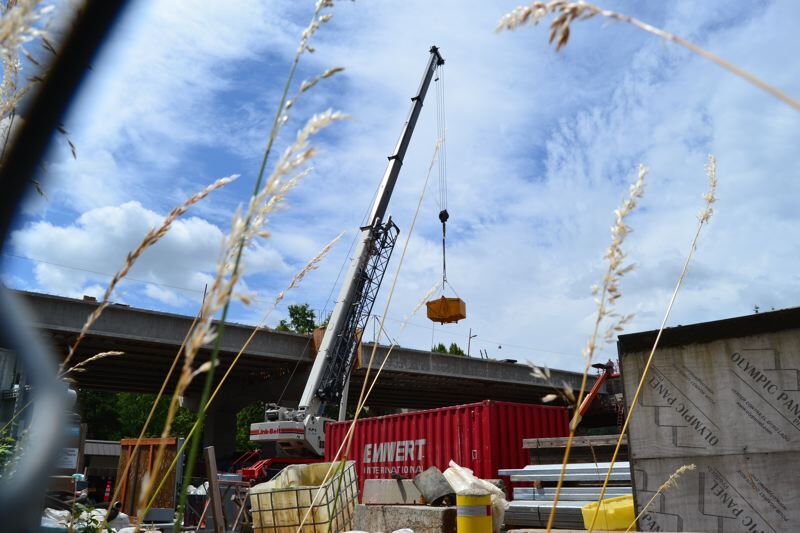Emmert takes down the Sellwood
Published 12:00 am Tuesday, June 14, 2016

- The new bridge is being built to withstand a major eathquake. Both the Burnside and Marquam bridges have had seismic upgrades, but those dont match the built-in strength of the new bridge designed to modern-day seismic standards.
If the Greek god Atlas were a modern-day company, it would be Emmert International, a globally recognized heavy-hauling business headquartered in Clackamas.
Trending
Currently, Emmert International is removing the old Sellwood Bridge as the new bridge nears completion (slated for November), and is known for moving the Spruce Goose airplane to the McMinnville museum in 1993 as well as the recent space shuttle fuel tank move to the California Science Center in Los Angeles.
Terry Emmert founded Emmert International (then Emmert Development Company) in 1965, designing, engineering and manufacturing the most advanced heavy-haul and rigging equipment in the industry.
“We have to do strength testing, test all of our lifting devices and pre-load,” Emmert said. “You use hydraulic pressure. You can put it against an item and pull test — in other words, the equipment is built and you can set it up and pressurize it to make sure lifting devices are using pressure and grabbing equally at all points.”
Trending
Last week, Emmert began to move the first of four segments of the old Sellwood Bridge, which range in weights from 400,000 to 500,000 pounds.
“We took the first section down last Friday and lowered it onto the barge, and now we’re prepping to get the next one ready,” Emmert said. “We place them on a barge and then take them downriver and then offload.”
It’s a slow, careful process.
According to Multnomah County, the original intent was to build the new bridge by halves, using the existing bridge for traffic as it went up. Once complete, traffic would have shifted to the new half, and the old bridge demolished. However, that would have cost $5 to $10 million more and resulted an extra year of construction time.
Multnomah County decided to build a “shoo-fly” bridge, or temporary bypass, for traffic while building the new bridge, which has a steel deck arch design, all at once.
“The equipment on the Sellwood Bridge is just to lift and break loose: in other words, we have to loosen it and then we have to lower it down 50 to 60 feet onto the deck of the barge,” Emmert said. “It’s really a controlled lift, a controlled lowering of (the bridge). It has to come down just perfectly in unison.”
And if something slips or tilts?
“It can’t. That’s a problem,” Emmert said. “The special system developed for that is a series of strandjacks that have cables that lower and then grab, lower and then grab.”
The crew will barge the pieces one at a time downriver to the Schnitzer scrap yard — at least, that’s the plan for now.
“The original path of travel for the bridge would’ve been about 13 miles, but that may change,” Emmert said. “It just depends on how fast they get the one section that we have loaded onto the barge, and how fast they offload that will determine how fast we come back for the next one to lower it down.”
The plans to receive the pieces at the scrap yard might see changes that will affect the plans and timeline, according to Emmert.
It’s not unusual for his company to make changes to carefully engineered transportation plans. A documentary “Levitated Mass” tracks Emmert’s project moving a 340-ton boulder from a stone quarry into the Los Angeles County Museum of Art for artist Michael Heiszer, in which Emmert spent 6,000 engineering hours finding a suitable route through numerous cities because the rock couldn’t fit beneath freeway overpasses that also weren’t strong enough to carry it.
Emmert never outsources work, only using its own specialized employees.
“We have some guys from Texas up here on the bridge because it’s hard to get people in our industry that are super qualified, because it’s very special,” Emmert said. “You need a great work ethic because it’s hard work. What we put together is just a great team.”
Local connection
Besides the Clackamas headquarters, Emmert International has three Texas locations. According to Emmert, his company has around 100 employees, including father-and-son teams and even someone’s grandson.
“We started here in Oregon in Clackamas, and we have a lot of our employees who went to LaSalle high school or Clackamas high school or Oregon or Oregon State universities,” Emmert said. “We got a lot of homegrown talent.”
The Sellwood Bridge is a place familiar to Emmert. He’s moved full houses across that bridge — shutting it down to all traffic, of course — although the width of the homes surpassed the edges of the bridge, hanging in the air over the river on both sides.
Emmert also moved a KFC across the Burnside Bridge, and a bank vault across the Freemont Bridge.
“We shut down the whole bridge, and we have to go slow,” Emmert said. “Going slow, there’s no impact.”
When it comes to the Sellwood Bridge, the four old pieces could be barged down the river over the next few weeks as the crew loosens the pieces and lowers them onto the barge one at a time.
“When you take something like that — the lifting devices and framework we fabricated there and all the testing we did here — there’s a lot to go into it to make sure it works perfectly smoothly,” Emmert said.







